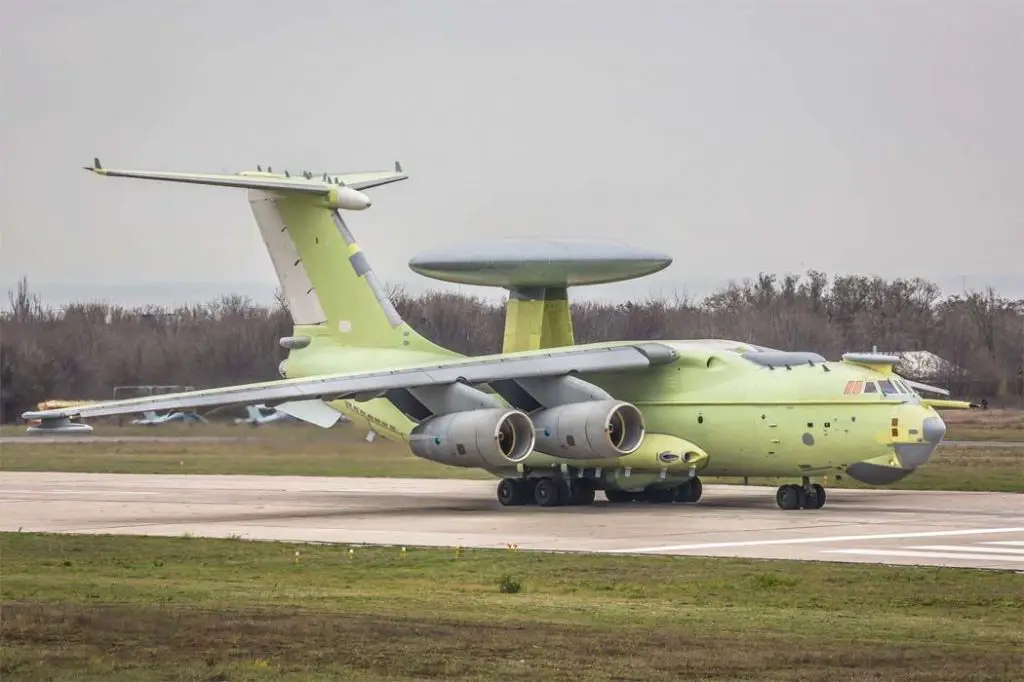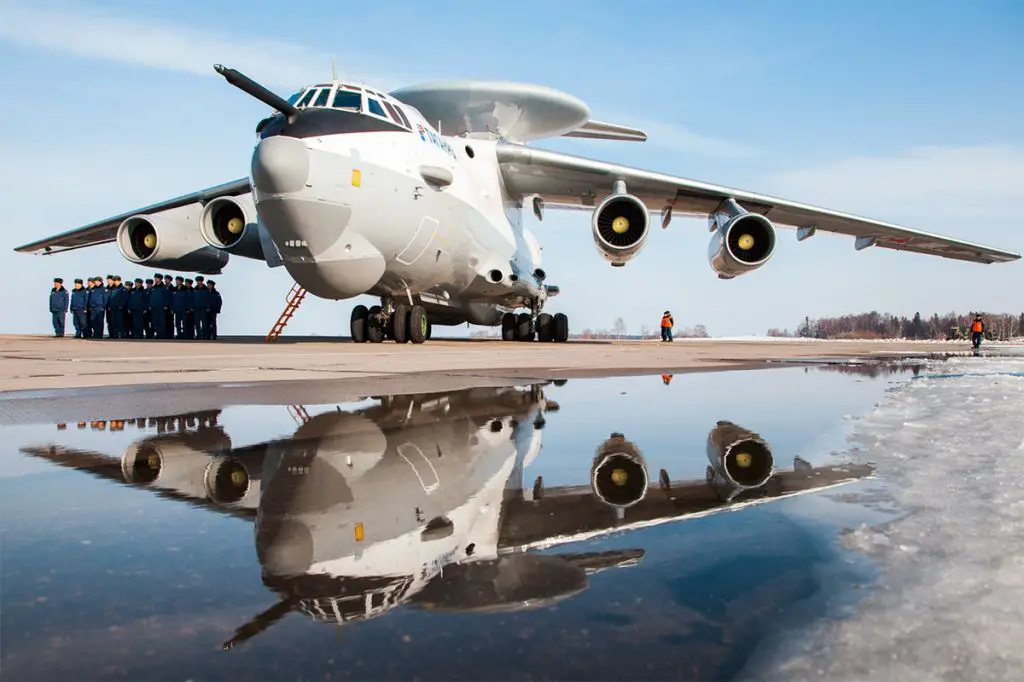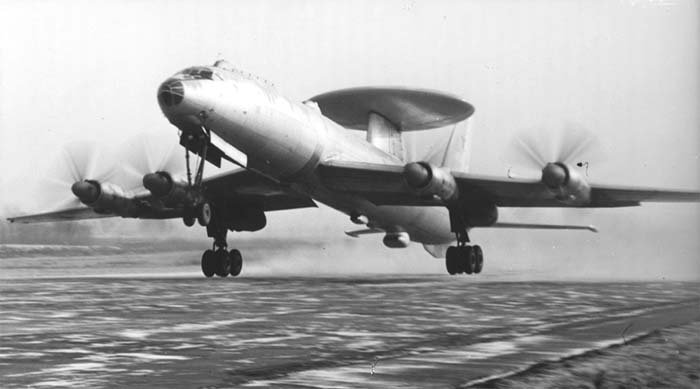The newest Russian flying radar A-100 Premier performed the first flight as part of ongoing tests with a working radar station.
The previous A-100 flight was reported in February 2019. The prototype “Premier” had performed the first flight as part of preliminary tests. Before that, the A-100LL flying laboratory performed several flights as part of flight design tests.
“The upcoming A-100 Premier radar patrol, guidance and control aircraft performed its first flight on February 9 as part of ongoing tests from the airfield in Taganrog with radar equipment turned on,” reported RIA Novosti, citing a source.
A Second A-100 is being built
In July 2020, the Russian government approved building a second A-100 plane. The completion date was not announced as it depends on the pace of production of the Il-76MD-90A, the platform used for the flying radar.
The A-100 Premier Project
Russia began working on experimental design work, “Premier-476”, to create a multifunctional aircraft for air surveillance and control in 2013. Currently, there is one prototype based on the Il-76MD-90A platform and one flying laboratory converted from the previous model of the Il transporter.
The completion of the building and testing of the A-100 is scheduled for 2024. After that, serial production of aircraft and the replacement of their predecessors – the A-50 and the modernised A-50U should begin.

The AWACS will be placed 200 km from the front line and can detect far into the depths of the enemy’s defenses. The latest AWACS aircraft can transmit target data fully automatic without using voice communication. The Russians say it is almost impossible to “muffle” it with electronic warfare.
The A-100 is being built by Vega concern. TANTK im. G.M. Beriev (part of Roselectronics and UAC of the Rostec corporation ) and several other organisations of the military-industrial complex are involved in the project. The Vega concern is building the A-100 to replace the A-50 AWACS aircraft in service.
Flying headquarters
The Russian Aerospace Forces use two types of AWACS aircraft. About two dozen A-50s were inherited from the USSR. Six of them have been upgraded to the A-50U level in recent years. They received improved radar and command centre equipment.
Compared to aircraft of the A-50 family, the tasks of the A-100 Premier are significantly expanded. This is also noticeable by its official name. The military department has designated the plane a “multifunctional aviation complex of radar patrol and guidance” (MAK RLDN).
According to the military, with the help of its radar, the Premier will be able to detect air and sea and ground targets. The officers and specialists on board will be able to direct high-precision land, air and naval weapons at the enemy.
The onboard communication equipment allows the aircraft to be integrated into modern automated control systems. It can transmit real-time ariel information to ground headquarters and air defense systems.
In recent years, the Russian Aerospace Forces have gained practical experience using AWACS aircraft in a combat situations. After the Western coalition attacks on the Syrian Shayrat airbase in 2017, one or two A-50s are constantly on duty at the Russian Khmeimim base. They are used to monitor the air situation over Syria.

The main advantage of the A-100 is the new dual-band phased array radar. It has an increased detection range and can better distinguish targets, including aircraft ‘invisible’ to conventional radars and cruise missiles created using stealth technologies.
According to the general designer of the Vega concern, with the new equipment, the aircraft surpasses all foreign analogues, including the American Boeing E-3 Sentry. The Russian flying radar can simultaneously track up to 300 targets at 650 km.
The modernised Il-76MD-90A aircraft produced in Ulyanovsk at the Aviastar-SP enterprise was chosen as the platform for the A-100. The lightweight design of the improved military transport aircraft, combined with new economic engines, made it possible to increase the patrol duration. It can be on duty a thousand kilometres from its base for six hours in the air. It can be refuelled in flight.
The aircraft received a digital control system and a modern “glass cockpit” with multifunctional indicators instead of mechanical instruments.
Under the Premier-476 program, the new radar equipment was first mounted on an old 1990 built AWACS A-50 aircraft. It became a flying laboratory, which worked out the individual elements of the complex.
The only new-build A-100 to date took off on November 18, 2017. In February 2019, it began testing all the equipment in the complex. Currently, specialists in development companies are engaged in fine-tuning equipment.
History of Russian early warning airborne radars
The Tu-126 aircraft with the Liana radio-technical complex was the first Russian long-range airborne radar. This aircraft was put into service in 1965.
The Liana system on the Tu-126 made it possible to detect air targets at ranges from 100 to 350 km and sea targets – up to 400 km. At the same time, the onboard equipment could transmit the information to the command posts of the air defense and the Navy at a distance of 2 thousand km from the aircraft. The Liana antenna was mounted on a tower above the fuselage, and it was the first domestic aircraft with a rotating mushroom-shaped radar.

At the end of the 20th century, a new tactic appeared to overcome air defense radar zones. The aircraft was flown at low altitudes, which gave out such a small signal compared to reflections from the earth’s surface that they became difficult to detect. There was a need for new AWACS aircraft to detect low-flying targets. So in 1978, the A-50 airborne early warning and control system was built based on IL-76.
The A-50 could detect air targets up to 650 km and ground targets up to 300. The aircraft can stay in the air for four hours, and refuelling almost doubled this figure.
In 2011, Russian military aviation received modernised A-50 with the letter “U”. Specialists of the Vega Concern, which is part of the Ruselectronics holding, took part in the modernisation of the aircraft.
In March 2019, the Vega Concern and the TANTK im. G.M. Beriev delivered the sixth A-50U to the Aerospace Forces of Russia. In parallel with the modernisation of the A-50 is underway. A-50U is called a transitional version to the new A-100 Premier aircraft.
